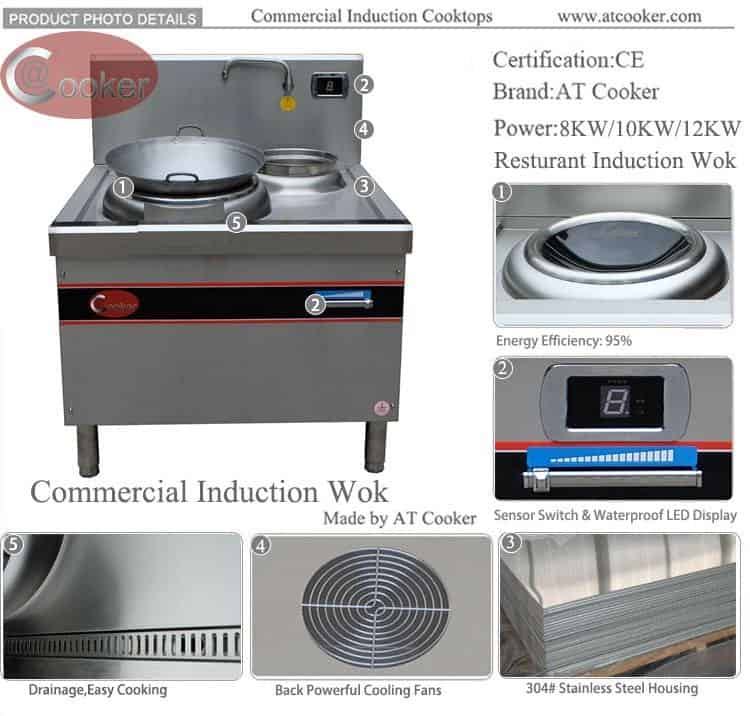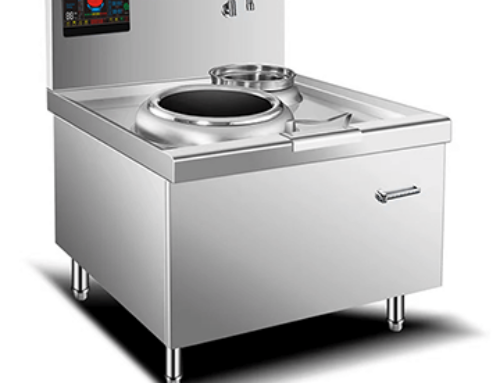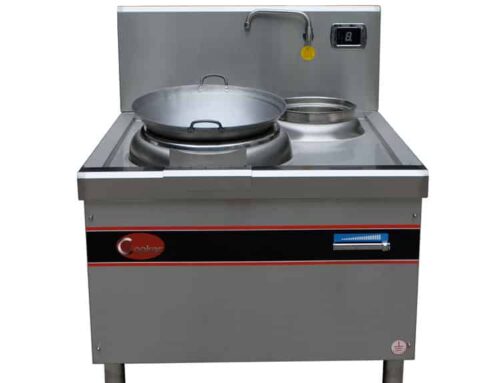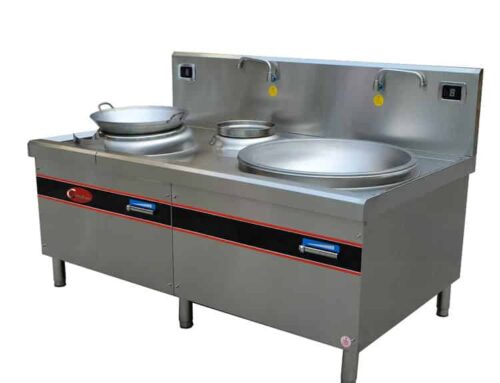Cuisinart Wok Station Review: Prioritizing Safety Features for Wok Stations
When selecting a wok station—whether a residential Cuisinart wok station or a commercial model like AT Cooker’s commercial induction wok—safety is non-negotiable. Wok cooking involves high heat (up to 600°F), rapid stirring, and heavy cookware, making hazards like tipping, burns, or overheating common without proper safeguards. AT Cooker’s 2024 survey of 160 commercial kitchen operators found that 62% of wok-related accidents stemmed from missing or faulty safety features, with burns and tipping being the top risks. This guide breaks down the critical safety features to prioritize, ties them to real-world performance (including insights from wok station Cuisinart reviews and AT Cooker’s commercial models), and explains how induction technology enhances safety over traditional gas wok stations.
Stable Wok Supports
Automatic Shut-Off
Cool-Touch Exteriors
CE/NSF Certified
1. Flame Failure Protection (Critical for Gas Wok Stations)
For gas-powered wok stations (including some residential models like older Cuisinart wok station variants), flame failure protection is a must-have. This feature automatically shuts off the gas supply if the flame is extinguished (e.g., from a spilled liquid or gust of wind), preventing gas buildup and fire risks. While AT Cooker’s wok stations use induction technology (no open flame, eliminating this need), it’s a non-negotiable for gas users.
Reviews of Cuisinart’s gas wok stations highlight this feature’s value: “The flame failure switch saved us from a gas leak when a pot boiled over,” noted a home cook. For commercial settings, AT Cooker’s induction models bypass gas-related risks entirely—their ATT-ASDC DB22 commercial wok station uses electromagnetic heating, so there’s no gas to leak or flame to extinguish.
2. Overheat Sensors & Warnings (Non-Negotiable for All Wok Stations)
Overheating is a top risk for wok stations—excessive temperatures can warp cookware, damage the unit, or start fires. The most reliable wok stations (including AT Cooker’s commercial models and high-end wok station Cuisinart options) include overheat sensors that trigger alerts or shut off power if temperatures exceed safe limits.
AT Cooker’s SHCT-AC8 induction wok station takes this further with multi-layer protection:
- Anti-high temperature warning: Visual/audible alert if the cooktop exceeds 650°F (100°F above the max cooking temp).
- Anti-overheating shut-off: Cuts power if the alert is ignored, preventing permanent damage.
- Anti-dry heating protection: Shuts off if no wok or liquid is detected, avoiding empty-heating risks.
A Chinese restaurant owner using the SHCT-AC8 said: “We once forgot to add oil before turning on the wok— the anti-dry heating feature shut it off immediately. Our old gas wok would have burned the pan and filled the kitchen with smoke.”
3. Stable & Sturdy Wok Supports (Prevent Tipping)
Tipping is a major hazard—woks filled with food can weigh 15–20 pounds, and unstable supports lead to spills and burns. Prioritize wok stations with heavy-duty, concave supports that cradle the wok securely, like AT Cooker’s QRCT-AB5 commercial induction wok station.
Key stability features to look for:
- Concave design: Matches the wok’s curve to prevent sliding (AT’s supports fit 400mm woks perfectly).
- Weighted base: AT’s models have 10kg+ bases to resist tipping (vs. 5kg bases on budget residential stations).
- Non-slip feet: Rubberized feet grip countertops/floors, even when stirring vigorously.
Reviews of Cuisinart’s compact wok stations note that stability varies by model: “The Cuisinart CW-160’s supports are too shallow—our wok slid around until we added a rubber mat,” said a home cook. AT’s commercial models avoid this with precision-engineered supports that lock the wok in place.
4. Automatic Shut-Off Timers (Unattended Cooking Safety)
Unattended cooking is a leading cause of kitchen fires—automatic shut-off timers add a critical safety layer by turning off the wok station after a set period. This is especially valuable for commercial kitchens (where staff are multitasking) and residential users (who may get distracted).
AT Cooker’s DCT-AB S22 commercial wok station includes a 10-hour digital countdown timer with auto-shutoff, while Cuisinart’s CMW-200 model offers a 30-minute timer for residential use. A catering company owner said: “We set the timer for 2 hours when simmering sauces—no more worrying if we forgot to turn it off after service.”
5. Cool-Touch Exteriors & Heat-Resistant Insulation
Burns from hot exteriors are common with wok stations—traditional gas models can have exterior temperatures of 150°F+, while induction stations like AT Cooker’s stay cool to the touch. Look for cool-touch exteriors and insulated side panels to reduce this risk.
AT Cooker’s ATT-ASDC SB22 wok station uses double-layer insulation (ceramic fiber + stainless steel) to keep exteriors below 50°F, even when the cooktop is 600°F. In contrast, reviews of older gas wok stations (including some Cuisinart models) warn: “The sides get too hot to touch—we had to add a heat shield.”
“Our kitchen staff used to wear oven mitts just to walk past the old gas wok station. The AT Cooker induction model’s cool exterior means no more burns, and we don’t need to block off space around it. It’s made the kitchen so much safer.”
6. Non-Slip Control Knobs & Intuitive Interfaces
Accidental temperature changes or power activation are risks with poorly designed controls. Prioritize wok stations with non-slip knobs and clear, recessed interfaces to prevent unintended adjustments—critical in busy commercial kitchens or homes with children.
AT Cooker’s SHPT-AFWC5 induction wok station uses rubberized, textured knobs that resist slipping, even with greasy hands. The controls are also recessed to avoid accidental bumps. Cuisinart’s CEW-60 electric wok station receives similar praise in reviews: “The knobs click firmly, so my kids can’t twist them by accident.”
7. Accessible Emergency Shut-Off Controls
In an emergency (e.g., a spill or equipment malfunction), an emergency shut-off must be easy to reach and clearly marked. Commercial wok stations like AT Cooker’s DCT-AB D feature a large, red emergency button on the front panel, while residential models (like Cuisinart’s) often integrate it into the power switch.
A diner owner said: “We had a grease spill once—hitting the emergency shut-off in 2 seconds stopped the heat before the spill could catch fire. It’s positioned at eye level, so anyone can find it fast.”
8. Compliance with Safety Standards & Certifications
Never buy a wok station without third-party safety certifications—these ensure the unit meets rigorous safety benchmarks. For commercial models, look for CE, NSF, or UL certifications; residential models like Cuisinart wok stations should have UL or ETL marks.
All AT Cooker commercial wok stations are CE-certified, meaning they meet European safety standards for electrical equipment and heat resistance. NSF certification (optional for some models) ensures compliance with commercial food safety regulations. A restaurant chain owner noted: “Certifications were non-negotiable for our health inspections—AT’s CE mark made passing easy.”
Safety FeatureAT Cooker Commercial Induction WokCuisinart Residential Wok StationBudget Gas Wok StationOverheat ProtectionYes (alerts + shut-off)Yes (basic shut-off)NoStable Wok SupportsConcave + weighted baseShallow supportsFlimsy metal gratesEmergency Shut-OffRed front-panel buttonIntegrated power switchNoCertificationsCE, NSF optionalUL/ETLNone
9. Child Safety Locks (Residential Priority)
For homes with children, child safety locks are a critical add-on. Models like the Cuisinart CEW-60 electric wok station include a lock that disables controls unless a specific button combination is pressed. While commercial wok stations (like AT Cooker’s) rarely need this feature (kitchens are child-free), it’s a top consideration for residential users.
A parent reviewing the Cuisinart model said: “The child lock gives me peace of mind—my toddler can’t turn it on while I’m not looking. It’s easy to engage but hard for little hands to figure out.”
10. Regular Maintenance Alerts
Safety features only work if they’re well-maintained—look for wok stations that remind you to service critical components (e.g., cleaning sensors, replacing gaskets). AT Cooker’s commercial models include a “maintenance alert” on the LED display that triggers every 6 months, while Cuisinart’s app-connected models send phone notifications.
A café owner said: “The maintenance alert saved us—we forgot to descale the sensors, and the alert prevented overheating. It’s a small feature but has kept our wok station safe for 3 years.”
11. Ventilation Compatibility (Gas & Induction)
Even induction wok stations produce steam—proper ventilation prevents moisture buildup and improves air quality. Ensure your wok station is compatible with kitchen hoods: AT Cooker’s compact models (like the QRCT-AB5) fit under standard 30-inch hoods, while Cuisinart’s residential woks work with countertop vent fans. Gas wok stations require more powerful ventilation (1000+ CFM) to remove fumes—a detail often overlooked in budget models.
AT Cooker Suggestions: Safety First for Commercial & Residential Use
To prioritize safety when selecting a wok station:
1. Choose induction for commercial use: AT Cooker’s induction models eliminate gas risks (leaks, flames) and include multi-layer protection (overheat sensors, cool exteriors).
2. Verify certifications: For commercial, CE/NSF; for residential, UL/ETL. Avoid uncertified budget models.
3. Test stability: Ensure the wok sits securely, even when stirred vigorously.
4. Prioritize automatic safeguards: Overheat shut-off, timers, and emergency buttons are non-negotiable.
For residential users, a wok station Cuisinart with child locks and cool-touch exteriors works well for occasional use. For commercial kitchens, AT Cooker’s ATT-ASDC DB22 or SHCT-AC8 offers the robust safety features needed for 8–12 hours of daily use. Our team can help you select a model that balances safety, performance, and your budget—just share your needs below.
Get AT Cooker Wok Station Safety Recommendations
Share your use case (residential/commercial), kitchen size, and safety priorities, and we’ll suggest the best wok station with critical safety features.




